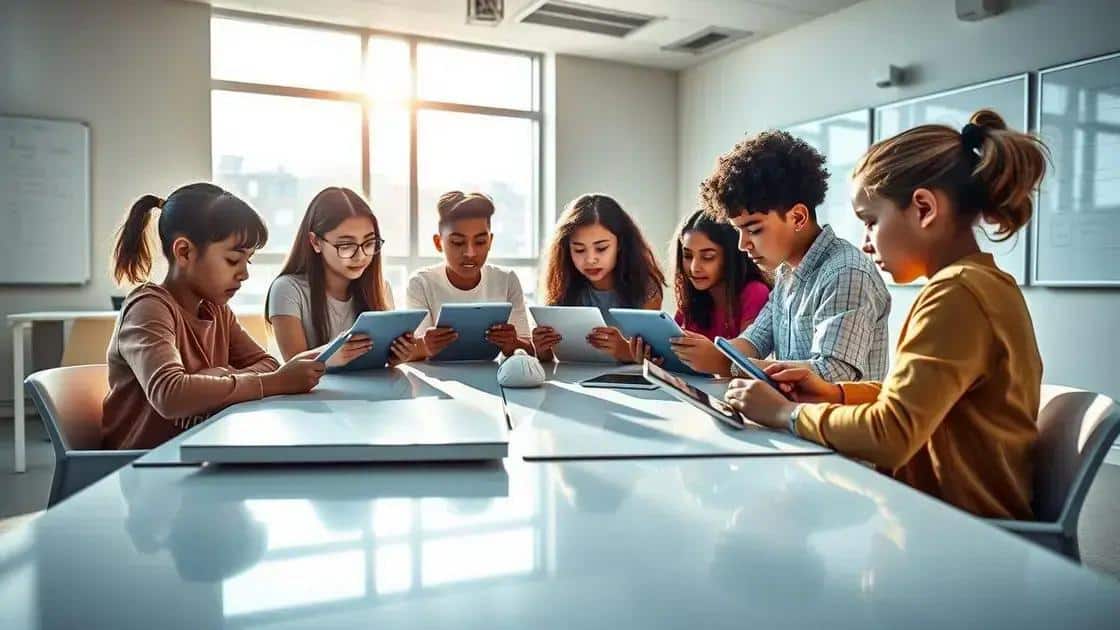School technology integration insights that enhance learning

Integrating technology in education enhances student engagement, supports personalized learning, and prepares students for future careers by equipping them with essential tech skills.
School technology integration insights are essential in today’s educational landscape. Have you ever wondered how the right tools can spark student interest and improve learning outcomes? Let’s dive into how technology reshapes the classroom experience.
Understanding the role of technology in education
Technology plays a crucial role in education today, transforming how students learn and teachers instruct. By integrating technology, schools have the opportunity to create more interactive and engaging learning environments.
Enhancing Learning Experiences
One of the main benefits of technology in education is the ability to enhance learning experiences. With tools like interactive whiteboards and educational software, students can participate in lessons more dynamically. This increases their interest and helps retain information.
Collaboration and Communication
Technology also promotes collaboration among students. Online platforms allow them to work on group projects from different locations. They can share ideas, files, and feedback easily, resulting in a richer learning environment.
- Collaboration tools for group projects
- Instant feedback mechanisms
- Access to diverse resources
Moreover, technology supports personalized learning. Every student has unique strengths and weaknesses. With technology, educators can tailor lessons to meet individual needs. This often leads to better understanding and improved grades.
Preparing for the Future
Incorporating technology into the classroom prepares students for a tech-driven world. As they use various tools and platforms, they develop skills necessary for future jobs. They learn not only subject matter but also how to adapt to technological advancements.
In conclusion, understanding the role of technology in education reveals its importance in modern classrooms. By fostering engagement and enabling personalized learning, technology equips students with skills for future success.
Benefits of integrating technology in schools

Integrating technology in schools offers numerous benefits that can positively impact both students and teachers. Technology enhances learning experiences, making education more engaging and effective.
Improved Engagement
One of the primary advantages of using technology is increased student engagement. Interactive tools, like educational games and multimedia presentations, help capture students’ attention. When lessons are fun and interactive, students are more likely to participate actively in class.
Personalized Learning
Another significant benefit is personalized learning. With technology, teachers can tailor content to meet individual students’ needs. This means that students can learn at their own pace, which is especially beneficial for those who might struggle with certain subjects.
- Customized learning paths
- Access to various resources
- Immediate feedback on performance
Technology also facilitates collaboration among students. Online platforms allow students to work together on projects, even when they are not physically in the same location. This leads to better communication skills and teamwork.
Access to Information
Moreover, integrating technology in schools gives students access to a wealth of information. The internet is filled with resources that can help deepen their understanding of various subjects. From videos to articles and online forums, students can explore topics more comprehensively.
Alongside these benefits, technology prepares students for the future job market. In a world that increasingly relies on tech skills, students equipped with these skills will have a competitive edge.
Challenges schools face in tech integration
While integrating technology in schools brings many advantages, there are also significant challenges that educators must tackle. Understanding these obstacles is essential for creating effective solutions that enhance learning.
Cost of Implementation
One major challenge is the cost of implementing technology in the classroom. Schools often have limited budgets, which can make it difficult to acquire the latest devices and software. Maintenance of existing technology also requires funds, which can strain school finances.
Training and Support
Another critical issue is the need for adequate training for teachers. Many educators may not feel confident using new technologies. Proper training sessions and ongoing support are necessary to ensure that teachers can effectively incorporate technology into their lessons.
- Professional development workshops
- Access to online tutorials
- Peer support and mentorship programs
Additionally, not all students may have equal access to technology at home. This creates a gap in learning opportunities. Schools need to find ways to ensure that all students can benefit from tech integration, regardless of their personal situations.
Resistance to Change
Resistance to change can also pose a challenge. Some teachers and staff may be hesitant to adopt new methods. They might prefer traditional teaching techniques and be unsure about how effective technology can be in enhancing their lessons. Overcoming this reluctance requires clear communication about the benefits of technology in education.
Overall, addressing these challenges is crucial for successfully integrating technology into schools. With thoughtful planning and the right resources, schools can create an innovative learning environment.
Real-life examples of successful technology integration

Real-life examples of schools successfully integrating technology provide a glimpse into the potential benefits of tech in education. These success stories highlight how technology can transform teaching and learning.
Classrooms Embracing Digital Tools
One notable example is a middle school that adopted interactive whiteboards. Teachers found that these tools made lessons more engaging. Students participated actively during lessons, which improved understanding and retention of the material. The interactive features allowed for dynamic discussions, leading to an enriched learning experience.
Flipped Classroom Model
Another successful approach is the flipped classroom model, where students learn new concepts at home using video lectures and then engage in activities in class. A high school in California implemented this model, allowing teachers to provide personalized support to students. They reported higher test scores and increased student satisfaction with learning.
- Improved student engagement
- Greater mastery of subject matter
- Enhanced classroom collaboration
A further example is a district that integrated learning management systems (LMS) to streamline communication between students and teachers. This system allowed students to access assignments, grades, and feedback easily. The district noticed that students were more responsible for their learning and became more proactive in asking questions and seeking help.
Using Mobile Technology
Additionally, a rural school leveraged mobile technology to bridge the educational resource gap. By providing tablets to students, the school ensured that all students had access to learning materials, regardless of their home environment. This initiative showcased how technology can promote equity in education.
These real-life examples illustrate that successful technology integration can offer substantial benefits. By embracing innovative tools and approaches, schools can create engaging, effective learning environments.
In conclusion, integrating technology into education brings many benefits but also presents challenges. Schools must find effective ways to embrace innovative tools while ensuring that all learners have equal access to resources. By sharing success stories, education professionals can inspire one another to create engaging and effective learning environments. Ultimately, the goal is to prepare students for the future by equipping them with the skills they need to thrive in a technology-driven world.
FAQ – Questions about Technology Integration in Schools
What are the main benefits of integrating technology in education?
Integrating technology enhances engagement, supports personalized learning, and improves collaboration among students.
What challenges do schools face when implementing technology?
Schools often struggle with costs, training for teachers, and ensuring equal access for all students.
How can technology prepare students for the future?
By equipping students with tech skills, schools prepare them for better job opportunities in a technology-driven world.
Can you provide examples of successful technology integration in schools?
Examples include the use of interactive whiteboards and the flipped classroom model, which have shown increased student engagement and improved learning outcomes.





